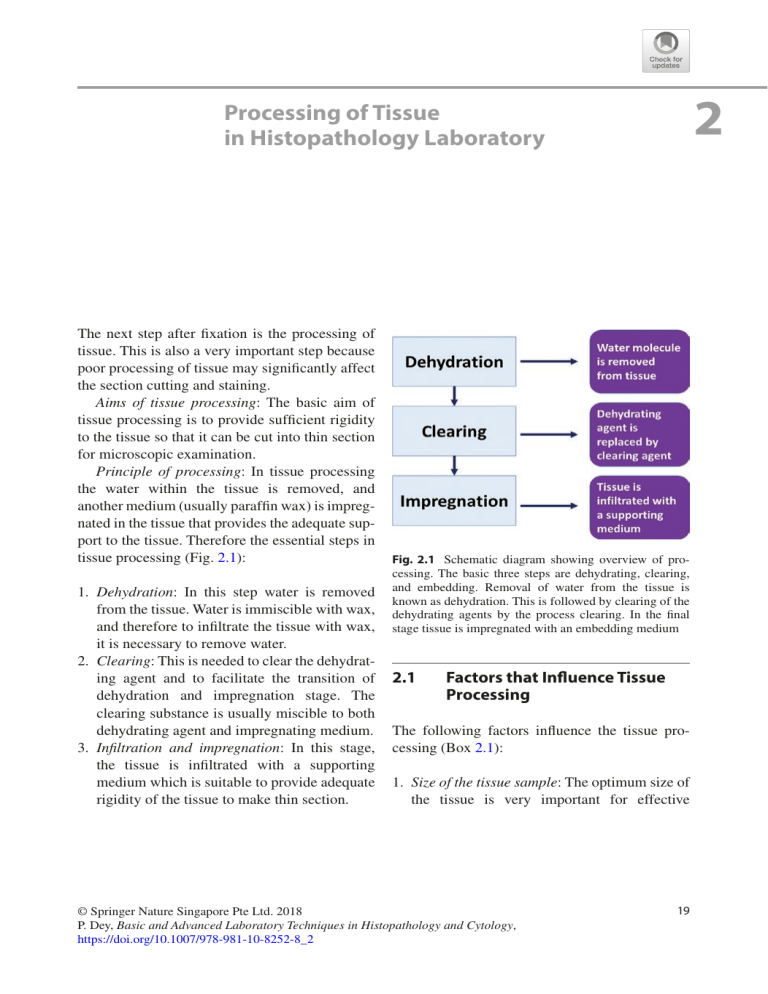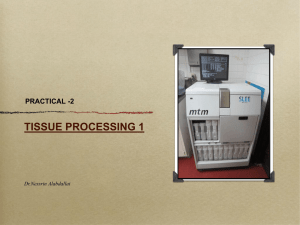Tissue Processing in Histopathology: Dehydration, Clearing, Embedding
advertisement

2 Processing of Tissue in Histopathology Laboratory The next step after fixation is the processing of tissue. This is also a very important step because poor processing of tissue may significantly affect the section cutting and staining. Aims of tissue processing: The basic aim of tissue processing is to provide sufficient rigidity to the tissue so that it can be cut into thin section for microscopic examination. Principle of processing: In tissue processing the water within the tissue is removed, and another medium (usually paraffin wax) is impregnated in the tissue that provides the adequate support to the tissue. Therefore the essential steps in tissue processing (Fig. 2.1): 1. Dehydration: In this step water is removed from the tissue. Water is immiscible with wax, and therefore to infiltrate the tissue with wax, it is necessary to remove water. 2. Clearing: This is needed to clear the dehydrating agent and to facilitate the transition of dehydration and impregnation stage. The clearing substance is usually miscible to both dehydrating agent and impregnating medium. 3. Infiltration and impregnation: In this stage, the tissue is infiltrated with a supporting medium which is suitable to provide adequate rigidity of the tissue to make thin section. Fig. 2.1 Schematic diagram showing overview of processing. The basic three steps are dehydrating, clearing, and embedding. Removal of water from the tissue is known as dehydration. This is followed by clearing of the dehydrating agents by the process clearing. In the final stage tissue is impregnated with an embedding medium 2.1 actors that Influence Tissue F Processing The following factors influence the tissue processing (Box 2.1): 1. Size of the tissue sample: The optimum size of the tissue is very important for effective © Springer Nature Singapore Pte Ltd. 2018 P. Dey, Basic and Advanced Laboratory Techniques in Histopathology and Cytology, https://doi.org/10.1007/978-981-10-8252-8_2 19 2 20 Box 2.1 Influencing Factors of Tissue Processing • Size of the tissue: –– The smaller the size, the better the processing. • Agitation: –– Agitation facilitates the contact of tissue with fresh solution. • Heat: –– Increases the better penetration of fluid. • Viscosity: –– The higher the viscosity of the medium, lower the penetration. • Negative pressure: –– Negative pressure removes trapped air in the tissue. –– Removal of clearing agent by increasing volatility. ­ rocessing. The smaller the size of the tissue, p better is the infiltration of the embedding medium. Optimum thickness of the tissue should be kept as 3–4 mm only. 2. Agitation: The tissue gets better contact with the surrounding medium if it is completely immersed and gently agitated. The agitation causes continuous removal of the fluid from the surface by fresh medium. This has better effect of action of fluid on the tissue. Most of the commercial tissue processors have the facility of agitation. It is important to note that too rapid agitation may damage the soft and delicate tissue. 3. Heat: Heat increases the rate of penetration of the fluid within the tissue, whereas low temperature impedes the whole process. The present commercial tissue processors have the facility to heat the tissue in all stages of processing. Overheating may produce hard and brittle tissue. 4. Viscosity: The viscosity of the embedding media also affects the processing. Higher viscosity of the medium lowers the penetration rate in the tissue. Heat reduces the viscosity of the medium and helps in better penetration. Processing of Tissue in Histopathology Laboratory 5. Vacuum: Application of negative pressure facilitates tissue processing [1]. Vacuum helps to remove the entrapped air from the tissue and thereby enhances the penetration of fluid within the tissue. Negative pressure also increases the volatility of the clearing agent and therefore helps to remove the fluid from the tissue. 2.2 Dehydration Every tissue contains some amount of free or unbound water molecule. As the commonly used supporting medium (paraffin) is not miscible with water, so it is necessary to remove the free water molecule from the tissue for the successful impregnation of the supporting medium (Box 2.2). The sharp difference of the concentration gradient between the tissues and the dehydrating fluid may cause sudden rush of fluid, and this may damage the delicate tissue. Therefore the dehydration should be done gradually from low Box 2.2 Dehydration • Removes free or unbound water molecule of the tissue as the supporting medium (paraffin) is not miscible with water. • Sharp difference of concentration gradient of the dehydrating fluid may damage the delicate tissue. • Gradual dehydration is necessary. • Too much time in the dehydrating fluid: the tissue becomes hard and brittle. • Routine laboratory: 70, 90 and 100% alcohol for 2 h each. • Common dehydrating agents: –– Ethyl alcohol –– Methylated spirit –– Methanol –– Butyl alcohol –– Isopropyl alcohol –– Dehydrating agents other than alcohol: dioxane, ethylene glycol and acetone 2.3 Individual Dehydrating Agent to high concentration of dehydration fluid. The tissue should be kept in the dehydration fluid for optimal time because too much time in the dehydrating fluid may cause the tissue hard and brittle. Too little time in dehydration fluid may be insufficient for removal of free water molecule. Thin 2–3 mm tissue needs less time in dehydration fluid than thick 5 mm tissue. 2.3 Individual Dehydrating Agent 2.3.1 Alcohol Ethanol Ethanol or ethyl alcohol is the most popular and most commonly used dehydrating agent. This is a clear and colourless fluid. Ethyl alcohol is flammable liquid. This is a relatively rapid and efficient dehydrating agent. However, it needs licence from the government to purchase ethyl alcohol for laboratory use. As a dehydrating agent ethyl alcohol is used in 50, 70, 90 and 100% concentration. For delicate tissue, the dehydration may be started from 30% concentration of ethyl alcohol. In routine laboratory, 70, 90 and 100% alcohol for 2 h each is ­sufficient for dehydration of the tissue. If tissue is immersed in the ethyl alcohol for long time, then the removal of attached water from the carbohydrate and protein molecules causes hard and brittle tissue. Anhydrous Cupric Sulphate in Final Container Anhydrous cupric sulphate (CuSO4) is a white powder that draws water from the alcohol and thereby helps in dehydration. About 1 cm layer of this powder is kept in the bottom of the container. The cupric sulphate powder should be covered with two to three layers of filter paper to prevent any colouring of the tissue. When the CuSO4 becomes hydrated, the colour of the powder changes to blue. This gives warning signal to change the alcohol and the CuSO4 powder. Advantages: 21 • Increases the life span of alcohol • Better dehydration • Good indicator to change alcohol Methylated Spirit It is also known as denatured alcohol. Methylated spirit contains 99% ethanol and 1% methanol or isopropyl alcohol. Methanol Methanol is a clear, colourless, volatile and inflammable liquid. It can be used as a substitute of ethanol, but it is rarely used in laboratory because of its volatility and high cost. Butyl Alcohol n-Butanol, isobutanol and tertiary butanol are used as dehydrating agents both in animal tissue and plant histology processing. Butyl alcohol is a slowly acting dehydrating agent and takes longer time than ethyl alcohol for dehydration. However the tissue shrinkage is less by butyl alcohol. Isopropyl Alcohol Isopropyl alcohol is available as isopropanol (99.8%). This is miscible with water and liquid paraffin. It is a relatively rapid acting, non-toxic dehydrating agent causing minimal tissue shrinkage. It is a good lipid dissolving solvent. 2.3.2 ehydrating Agents Other D than Alcohol Dioxane This is 1,4-diethylene dioxide. Dioxane is miscible with both water and molten paraffin wax. This is a rapidly acting dehydrating agent and produces very little shrinkage. Tissue can be kept in dioxane without any harm. Dioxane liberates highly toxic gas and proper ventilation is mandatory for its use. Ethylene Glycol It is also known as ethylene glycol monoethyl ether or cellosolve. It is a colourless and odourless fluid. Cellosolve is a rapidly acting dehydrating and tissue can be kept in it for long duration. Acetone Acetone is a colourless and inflammable liquid with a pungent ketonic smell. It is 2 22 Processing of Tissue in Histopathology Laboratory Table 2.1 Comparison of different dehydrating agents Dehydrating agents Ethyl alcohol Advantages • Rapid and efficient dehydrating agent Methanol • Equally effective as ethanol Isopropyl alcohol • • • • • • • • Dioxane Ethylene glycol Acetone Relatively rapid action Non-toxic Minimal tissue shrinkage Rapid action No shrinkage of tissue Rapid No graded solution is needed Tissue can be kept in it for long time • Rapid action • Cheaper than ethanol • Good for fatty tissue processing Disadvantages • Needs licence from the government • Inflammable • Hard and brittle tissue if kept for long time • Volatile • High cost • Not possible to use in celloidin technique • Highly toxic gas is generated • Very expensive • Clearing agent is needed • Quickly evaporates • Inflammable • Prolonged use may cause shrinkage and brittleness of tissue ­ iscible with both water and alcohol. Acetone m produces tissue shrinkage and prolonged use may cause brittleness of tissue. It is best used in fatty tissue processing. The various dehydrating agents are compared in the Table 2.1. • Type of processor: manual versus automatic • Processing condition: temperature and vacuum • Speed of removal of dehydrating agent • Ease of replacement by molten wax • Safety factors: flammability and toxicity • Cost 2.4 The clearing agent with low melting point is easily and quickly removed by the molten wax. Whereas, clearing agent with high melting point takes time to be removed by embedding medium. Clearing agent with high viscosity has low penetration rate. Prolonged exposure of the tissue in clearing agent may make the tissue brittle and more friable. Therefore optimal time for clearing is necessary. The amount of clearing agent should be 40 times of the volume of tissue for clearing. Clearing After the removal of free water molecule from the tissue, the next step of processing is to remove the dehydrating agent itself from the tissue because many dehydrating agents are not miscible with the impregnating material (paraffin wax). The clearing agent should be miscible with both the dehydrating agent and the embedding medium. The refractive index of the clearing agent is similar to the tissue, and therefore it gives clear appearance of the anhydrous tissue (Box 2.3). So the completely transparent tissue indicates the terminal point of the clearing process. Any opacity of tissue signifies incomplete dehydration. Selection of appropriate clearing agent: This depends on: • Type of tissue: large tissue takes more time than smaller tissue 2.4.1 Individual Clearing Agent Xylene This is the most commonly used clearing agent in the laboratory. This is a clear and inflammable liquid. The small pieces of tissue are cleared rapidly by xylene within 30–60 min. Prolonged exposure to xylene may make the tissue hard and brittle. 2.4 Clearing 23 Box 2.3 Clearing • Aims of clearing: –– Removal of dehydrating agent (e.g. alcohol) to facilitate impregnation of paraffin wax –– To make the tissue clear and improve the microscopic examination • Ideal clearing agent: –– Low viscosity and high penetration rate –– Low melting point –– Miscible with both alcohol and molten wax –– No tissue damage –– Less toxic –– Less inflammable –– Cheap • Selection of appropriate clearing agent: Type of tissue, type of processor, processing condition (such as heat, vacuum) safety factors and cost • Volume of clearing agent: 40 times the volume of the specimen • Total duration: –– Smaller biopsy: 1 h –– Larger tissue: Three changes in xylene or toluene 60 min each • End point detection: Tissue becomes transparent • Prolonged exposure to clearing agent: The brittle and more friable tissue • Different clearing agents: Xylene, toluene, chloroform, amyl nitrate, cedarwood oil and limonene Table 2.2 Comparison of clearing agents Properties Tissue shrinkage Tissue hardening Inflammable Harmful effect Cost Xylene Yes Yes Yes Irritant but less harmful Cheap Toluene Yes No Yes Irritant Cheap Toluene It has almost similar properties as that of xylene. However it does not make the tissue hard even after prolonged exposure, and its action is slightly slower than xylene. Toluene is also flammable and toxic. Chloroform It is highly volatile, non-­inflammable, expensive and toxic agent. The penetrating power of chloroform is slower than xylene. However, it does not cause any tissue shrinkage and is mainly used in the uterus, muscle and other dense tissue. Presently chloroform is rarely used in laboratory. Table 2.2 compares the different clearing agents commonly used in laboratories. Chloroform Minimum No No Dangerous toxic gas liberates in heating Very expensive 2.4.2 Esters No No Yes Safe High cost Other Clear Agents Esters The different esters are amyl nitrate, methyl salicylate and methyl benzoate. These are less toxic and may be used in manual processing. They do not cause tissue hardening even under prolonged exposure. Cedarwood Oil This is an expensive rapid clearing agent and mainly used in clearing dense tissue. Limonene This is a clear liquid. It does not cause any tissue hardening. However, the removal of limonene from the tissue by paraffin wax is difficult. 2 24 2.5 Infiltration and Embedding This is the next step after clearing. The clearing agent within the tissue is removed by the process of diffusion. The tissue space is now infiltrated with the embedding media. Usually molten wax is used as the embedding medium. After cooling in room temperature, the molten wax is solidified to provide support for cutting into thin section (Box 2.4). Ideal impregnating medium: An ideal impregnating medium should have following qualities: • Miscible with clearing agent • Liquid in higher temperature (30–60 °C) and solid in room temperature • Homogenous and stable • Non-toxic and cheap • Transparent • Fit for sectioning the tissue The time duration and the number of changes required for the impregnation in tissue depends on: Processing of Tissue in Histopathology Laboratory 1. Size of tissue: Thicker large tissue takes more time to impregnate with the embedding medium. It also contains more clearing agent to remove. 2. Type of tissue: Hard tissue such as bone and cartilage takes more time for embedding than soft tissue. 3. The type of clearing agent: Certain clearing agents are easy to remove than others. Such as xylene and toluene are easy to remove than cedarwood oil. 4. Type of processing: Vacuum embedding enhances impregnation. 2.5.1 Different Impregnating Medium 2.5.1.1 Paraffin Wax Paraffin wax is a type of hydrocarbon and is produced as by-product during refining of crude petroleum. This is the most popular universally accepted embedding medium for tissue processing. This is non-toxic and inexpensive medium. The melting point of paraf- Box 2.4 Impregnation of Embedding Medium Aims: To provide support to the tissue. Principle: Clearing agent is removed by the process of diffusion, and the tissue space is now infiltrated with the embedding media. Ideal impregnating medium: • • • • • • Miscible with clearing agent Liquid in higher temperature and solid in room temperature Homogenous and stable Non-toxic and cheap Transparent Fit for sectioning the tissue Time duration and the number of changes of embedding medium: • • • • Size of tissue: Large versus small. Type of tissue: Hard versus soft. The type of clearing agent: Cedarwood oil takes longer time. Type of processing: Vacuum processing accelerates. Different embedding medium: Paraffin wax and dimethyl sulphoxide. 2.6 Tissue Processing Methods fin wax varies from 39 °C to 70 °C. The wax is sold according to its melting point. Paraffin wax with low melting point is soft in room temperature, whereas paraffin wax of higher melting point is much harder in consistency. Therefore, it is necessary to have paraffin wax that has suitable melting point to get good ribbon of tissue. In this Indian subcontinent, the paraffin wax with melting point around 60 °C is the most suitable for laboratory use. Total 3–4 h’ time in paraffin wax is sufficient for impregnation of tissue by wax. Advantages of paraffin wax: • • • • Tissue block can be stored for long duration. Non-toxic. Cheap. Safe. Disadvantages of paraffin wax: • It may cause tissue shrinkage and hardening in case of prolonged impregnation. • Paraffin wax takes long duration for the impregnation of the bone and eye. 2.5.1.2 Additives and Modification of Paraffin Wax To alter the physical characteristics of paraffin wax, the following modifications may be done: 1. To increase hardness: addition of stearic acid 2. Reduction of melting point: addition of phenanthrene 3. Improving adhesiveness with tissue and wax: addition of 0.5% of ceresin 25 a handful number of tissue. Automated tissue processor is widely used in laboratories. Automated tissue processor: The basic principle of tissue processor is to transfer the tissue in different fluid for a specified time in a desired environment. There are two types of tissue processor: 1. Tissue transfer processor 2. Fluid transfer processor 1. Tissue transfer processor (Fig. 2.2): In this system the bucket of tissue is transferred from one carousel to other after a specified time. There are several containers with reagents. Tissue remains in a basket with 30–100 cassettes. The basket containing the tissue is submerged in the specific container for a particular time and then transferred to the next container automatically. A gentle agitation is created by vertical oscillation or by rotatory movement of the tissue basket. The time schedule and transfer of tissue in each container are determined by a microprocessor. 2. Fluid transfer processor (Fig. 2.3): This is a completely closed processor. Here the tissue is kept in the container, and the container is ­periodically filled with particular fluid. After a certain period, the fluid is pumped out from the container containing the tissue. It is again filled with the fluid required for the next step. In this processor each step can be customized for vacuum, temperature, and time duration. Dimethyl Sulphoxide (DMSO) The addition of small amount of DMSO in paraffin wax reduces the infiltration time of the wax and removes the residual clearing agent. It produces a homogenous matrix and better support. 2.6 Tissue Processing Methods Tissue processing can be done by simple manually or by automated processor. Manual tissue processing is done only in a small laboratory with Fig. 2.2 Tissue transfer automatic tissue processor. Here the whole bucket containing tissue is automatically transferred to the next fluid station 2 26 Processing of Tissue in Histopathology Laboratory Alcohol (graded) 70% 50% 90% Alcohol (100%) Paraffin IHr Embedding IHr Fig. 2.3 Fluid transfer advanced automatic tissue processor. Here the fluid itself is changed automatically, and the bucket remains static Dehydration IHr Paraffin 100% IHr IHr 2.7 verall Precautions of Tissue O Processing 1. The bulk of the tissue should be optimum for adequate penetration of fluid. 2. The amount of fluid should be adequate and the fluid level should be always higher than the tissue level. 3. The tissue basket and cassettes should be clean and any spillage of wax should be cleaned. 4. The temperature of the infiltrating medium should be optimum, and it is preferable to keep the temperature 3–4 °C above the melting point. 5. There should be a proper record of the change of fluid, number of tissues processed, etc. 2.7.1 ime Schedule for Overnight T Processing (Fig. 2.4) 50% ethanol: 1 h 70% ethanol: 1 h 100% IHr Clearing Paraffin 100% Xylene Xylene Xylene IHr Advantages: 1. Vacuum pressure makes the system faster and efficient. 2. In this closed system, there is no chance for tissue drying. IHr IHr IHr IHr IHr Fig. 2.4 Schematic diagram showing the time schedule of overnight processing 90% ethanol: 1 h Absolute alcohol: 1 h Absolute alcohol: 1 h Absolute alcohol: 1 h Xylene/toluene: 1 h Xylene/toluene: 1 h Xylene/toluene: 1 h Paraffin wax: 1 h Paraffin wax: 1 h Paraffin wax: 1 h 2.7.2 Manual Tissue Processor It is rarely used in routine laboratory. The advantage of manual processing are: 1. Small number of samples can be processed in a small laboratory. 2. Careful monitoring in each step is possible. 3. In case of emergency when the automated tissue processor is not working, one can take the help of the manual processing. 4. In case of manual processing, it is possible to select the reagents of choice with flexibility in time duration. References 27 Table 2.3 Troubleshooting in processing Problem Tissue is soft during embedding Tissue is coming out from the block during sectioning Microchattering effect around the edges of the tissue section Cause 1. Tissue is too thick during grossing 2. Reagents are saturated with water 3. Paraffin is saturated with clearing agent e.g. Xylene Dehydration process is inadequate, so there is defective paraffin infiltration in the tissue Excessive dehydration Cracked and folded tissue section Excessive dehydration Irregular staining of haematoxylin and eosin stain Brittle tissue after processing Dehydration process is suboptimum Excessive blood in tissue The major disadvantages of manual processing include inconvenient for processing and time taken procedure. 2.7.3 Microwave Processing Microwave processing in histopathology reduces the time of processing significantly [2]. It is suitable for small number of delicate tissues. The microwave oven usually has: 1. System to control the temperature 2. System to control the time duration of particular temperature 3. Proper exhaust to remove the toxic gas Remedies 1. Tissue should be properly cut 2. Change the reagents 3. Change paraffin Change the processing program and give adequate time for dehydration Change the dehydration time. It is better to process the smaller biopsy tissue separately from the larger tissue to have proper dehydration The block is soaked with a wet gauze piece before sectioning Change the processing program, and give adequate time for dehydration Apply a gauze piece soaked with warm water on the surface of the block before sectioning The microwave processing may be used for all the steps of processing. Tissue processing for electron microscopy: See Chap. 26. Troubleshooting in processing is highlighted in Table 2.3. References 1. Brain EB. Infiltration histological specimens with paraffin wax under vacuum. Basic factors and a new approach. Br Dent J. 1970;128(2):71–8. 2. Leong AS, Leong FJ. Strategies for laboratory cost containment and for pathologist shortage: centralised pathology laboratories with microwave-­ stimulated histoprocessing and telepathology. Pathology. 2005;37(1):5–9.



